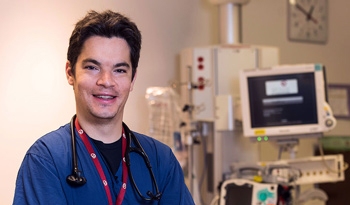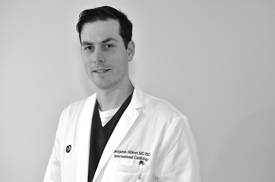Researchers at the University of Ottawa Heart Institute recently made an observation that has helped inform clinical practice in the treatment of patients with severe cardiogenic shock, a condition in which the heart suddenly can't pump enough blood to meet the body's needs.

In a recent study published in the Journal of the American College of Cardiology, Interventional Cardiology Fellow Dr. Juan Russo et al found left ventricular unloading was associated with improved clinical outcomes when used in patients treated with venoarterial extracorporeal membrane oxygenation (VA-ECMO) for cardiogenic shock. In the absence of a randomized controlled trial, the research suggests left ventricular unloading should be considered in appropriately selected patients undergoing VA-ECMO for cardiogenic shock.
Did you get all that? Let’s break it down using an example.
A young patient, say between 40- to 50-years old, suffers a massive heart attack. Their lack of blood flow leaves the heart muscle stunned. The heart is now temporarily weakened and no longer able to pump enough blood to the body’s vital organs. Soon those organs begin to fail. Medications alone often cannot restore the heart’s function quickly or sufficiently enough – and now time is of the essence. Without a way of supplying blood to the body’s vital organs, the patient will often not survive.
VA-ECMO is not an end goal, but rather a potential life-saving bridge to recovery or a more durable support strategy.
- Dr. Juan Russo, Cardiology Fellow, UOHI
That’s essentially what VA-ECMO does. It helps to temporarily provide blood flow to vital organs. The technique is adopted by clinicians to provide temporary mechanical circulatory support to adults with cardiogenic shock. Dr. Russo says VA-ECMO is “not an end goal, but rather a potential life-saving bridge to recovery or a more durable support strategy.” In other words, VA-ECMO is the currency that buys clinicians and cardiac shock patients what they often need most – time.
VA-ECMO’s efficacy, safety and optimal implementation however, have not been well-studied. Complicating matters more, the available literature does not suggest clinical outcomes in patients treated with VA-ECMO are improving.
One of the principal drawbacks of VA-ECMO is an increase in ventricular afterload – the pressure or strain a weakened heart must overcome to eject oxygenated blood to feed the body’s vital organs. Too much of it can lead to dramatic complications: myocardial ischemia, delayed ventricular recovery, ventricular arrhythmias, pulmonary edema, thrombotic events, and multiorgan dysfunction.
Would interventions to lessen the load on the heart during the provision of VA-ECMO have life-saving implications for adult patients with cardiogenic shock?

Russo and his colleague at the Heart Institute, senior author and Interventional Cardiologist Dr. Benjamin Hibbert, et al conducted a systematic review of the literature to determine this possibility.
The authors searched Medline, EMBASE, and the Cochrane library for studies that (1) examined the use of VA-ECMO for cardiogenic shock in adults, and (2) provided data on mortality in patients with vs. without a left ventricular unloading strategy during VA-ECMO. Of more than 2,000 studies observed, 17 met the inclusion criteria.
In total, 3,997 patients were included, 42% of which received a left ventricular unloading strategy during VA-ECMO. Those strategies included the insertion of an intra-aortic balloon pump, percutaneous ventricular assist device, or pulmonary vein or transseptal left atrial cannula. The primary outcome, all-cause mortality, was lower in patients who had received an unloading strategy (54%) vs. those who had not (64%). On the flip side, important safety outcomes were not demonstrably different in patients treated with VA-ECMO with vs. without left ventricular unloading.
In order to validate these results, this hypothesis would have to be tested in a definitive randomized controlled trial. A study of this magnitude can take years to conduct. In the meantime, however, patients still need to be treated. Summarizing the available data is an important first step towards improving clinical outcomes.

